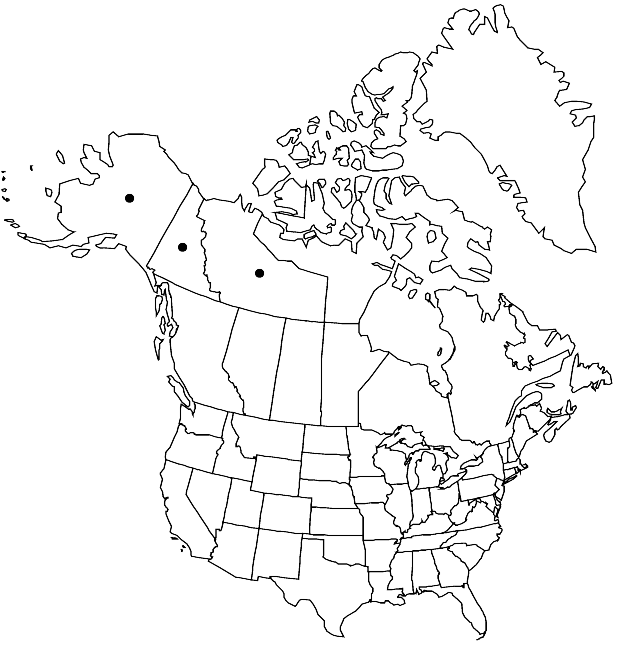Difference between revisions of "Physaria calderi"
Novon 12: 322. 2002.
FNA>Volume Importer |
imported>Volume Importer |
||
| (5 intermediate revisions by 2 users not shown) | |||
| Line 8: | Line 8: | ||
}} | }} | ||
|common_names=Calder’s bladderpod | |common_names=Calder’s bladderpod | ||
| − | |basionyms={{Treatment/ID/ | + | |basionyms={{Treatment/ID/Basionym |
|name=Lesquerella calderi | |name=Lesquerella calderi | ||
|authority=G. A. Mulligan & A. E. Porsild | |authority=G. A. Mulligan & A. E. Porsild | ||
| + | |rank=species | ||
| + | |publication_title=Canad. J. Bot. | ||
| + | |publication_place=47: 215, plate 1. 1969 | ||
}} | }} | ||
|synonyms={{Treatment/ID/Synonym | |synonyms={{Treatment/ID/Synonym | ||
|name=Lesquerella arctica subsp. calderi | |name=Lesquerella arctica subsp. calderi | ||
|authority=(G. A. Mulligan & A. E. Porsild) Hultén | |authority=(G. A. Mulligan & A. E. Porsild) Hultén | ||
| + | |rank=subspecies | ||
}} | }} | ||
|hierarchy=Brassicaceae;Brassicaceae tribe Physarieae;Physaria;Physaria calderi | |hierarchy=Brassicaceae;Brassicaceae tribe Physarieae;Physaria;Physaria calderi | ||
| Line 39: | Line 43: | ||
-->{{#Taxon: | -->{{#Taxon: | ||
name=Physaria calderi | name=Physaria calderi | ||
| − | |||
|authority=(G. A. Mulligan & A. E. Porsild) O’Kane & Al-Shehbaz | |authority=(G. A. Mulligan & A. E. Porsild) O’Kane & Al-Shehbaz | ||
|rank=species | |rank=species | ||
| Line 54: | Line 57: | ||
|publication year=2002 | |publication year=2002 | ||
|special status= | |special status= | ||
| − | |source xml=https:// | + | |source xml=https://bitbucket.org/aafc-mbb/fna-data-curation/src/2e0870ddd59836b60bcf96646a41e87ea5a5943a/coarse_grained_fna_xml/V7/V7_1027.xml |
|tribe=Brassicaceae tribe Physarieae | |tribe=Brassicaceae tribe Physarieae | ||
|genus=Physaria | |genus=Physaria | ||
Latest revision as of 22:29, 5 November 2020
Perennials; caudex simple or branched; densely pubescent throughout, trichomes (sessile or subsessile), rays distinct or slightly fused at base, furcate or bifurcate, (strongly umbonate, tuberculate, tubercles often relatively larger, fewer over center). Stems simple or few to several from base, usually erect to spreading, sometimes prostrate, 0.5–2 dm. Basal leaves: blade oblanceolate, 2–3 cm, margins entire. Cauline leaves (sessile or proximal shortly petiolate); blade narrowly oblanceolate, 0.5–1.5 cm, margins entire. Racemes loose. Fruiting pedicels (erect to divaricate or ascending, sometimes curved), (5–)10–20(–40) mm, (stout). Flowers: sepals ovate to elliptic, (3–)4–5(–6) mm, (median pair often thickened apically, cucullate); petals obovate, (6–)7–10 mm (nearly as wide, abruptly narrowed to claw, ca. 1 mm wide). Fruits subglobose to ellipsoid, compressed (usually angustiseptate), to 8 mm; (valves not retaining seeds after dehiscence); replum as wide as or wider than fruit; ovules 10–14 per ovary; style 1–2 mm. Seeds plump. 2n = 20.
Phenology: Flowering Jun–Aug.
Habitat: Dry rocky summits, limestone flats and slopes, alpine knolls
Elevation: 600-1500 m
Distribution

N.W.T., Yukon, Alaska.
Discussion
Physaria calderi is known from the Ogilvie and Richardson mountains.
Selected References
None.